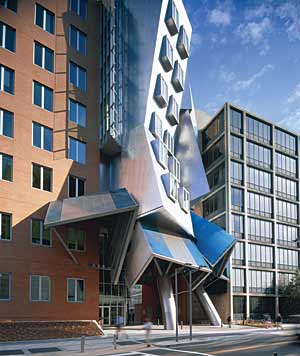When Frank Gehry’s Stata Center at MIT opened three years ago, it got a lot of press, especially for its novel appearance. I wrote at the time [record, July 2004, page 61]: “It looks as if it’s about to collapse. Columns tilt at scary angles. Walls teeter, swerve, and collide in random curves and angles. Materials change wherever you look: brick, mirror-surface steel, brushed aluminum, brightly colored paint, corrugated metal. Everything looks improvised, as if thrown up at the last moment.” The Stata was even pictured in a Doonsbury comic strip, where a character calls it “pretty cool.”

Then everybody forgot about it and moved on. There were fresher shocks to delight us. But the Stata, like any building, is more than a visual show. It’s also a set of interior spaces where people study, play, socialize, and run experiments. The spaces either work or they don’t. You can’t make that judgment until a building has been around for a while.
So let’s ask that simple question. Does the Stata work? Or is it merely an act of self-expression? Is it architectural sculpture? Or is it—to use a word that now sounds quaint—functional? What were its purposes, anyway?
The biggest goal for the project was to get MIT scientists—and that includes students—to meet one another. Too often, it was felt, they were holed up in isolated labs, apartments, and classrooms. Says Gehry: “The main problem I was given was that there are seven separate departments that never talk to each other. [But] when they talk to each other, if they get together, they synergize and and make things happen, and it’s gangbusters.”
The Stata, thus, was to be a mixing chamber. People would make connections. They’d begin to feel like members of a community. Barriers between disciplines would fall. Great minds would meet, copulate, and spawn brilliant ideas.
Two groups were to be the primary beneficiaries: computer sciences and artificial intelligence. Most of the people in the Stata are in one of those fields, figuring out how thinking takes place and how it can be improved and communicated, whether in a brain, a computer, a network, or a robot. Smaller groups at Stata are linguists, philosophers, and biologists who study DNA.
After a month of wandering the Stata’s trackless and confusing floors (they are), and talking to its delighted inhabitants (they are), I’m ready to say: Yes, it does work. In the ways that count most, the Stata is a wonderful and astonishing building. Let’s list its virtues. From here on, every comment in quotation marks was made to me by a Stata professor, researcher, student, or staff member.
The Stata is a building with lots of problems, inhabited by guys who love to solve problems. The MIT scientists would have been bored by a conventional building. Gehry gave them a building that needs to be solved. The floor plans are at first a mess, as noted. As you hunt down the person you’re there to see, you feel like a rat looking for the cheese in a maze. Except for the ground floor “Student Street,” there isn’t—at first—any apparent order to the circulation.
But the scientists love the complexity. You just wander around till you get where you’re going. “You may run into people and projects you knew nothing of,” says one. Says another, joyful at the memory: “It took them a day to cut my furniture to fit the sloping and bending walls in my office.” That was a problem, and he found a solution. Another likens his office to living in a work by Richard Serra. These are guys who like challenges. They like having to figure things out. Life in the Stata can be a continual brain game. (Okay, it might not suit everyone.) “Nine out of 10 faculty would say they are really pleased,” notes one. “Everyone wants to say they’re unconventional.”
The Stata is fractal instead of linear. Three professors compared the floor plan to fractals. “We made a 3D graph,” says one, “of all the research groups we’d like to sit next to. We found that you couldn’t do that in only two dimensions.” Gehry’s plan, which everyone calls “neighborhoods,” gets as close to that ideal as possible.
A neighborhood is a cluster of private offices opening off a shared space that one staffer calls a “town green.” Usually the shared space is two stories high and often it’s skylit, so the neighbor connections work both horizontally and vertically.
Research at Stata is group focused, and the groups come in many sizes. There are, therefore, many possible orders of magnitude. You can define your research zone as a whole floor, or as two or three neighborhoods, or as just one neighborhood, or maybe as just your own office and a share of its town green. This is what makes Stata fractal, the way it breaks down in steps from large clusters to small, each one of which, at every scale, can be thought of as a centered whole.
“You can’t do that in a linear building, with rooms off a corridor,” says one person. Another sees the plan as metaphor: “For a lot of the deep issues in computer science here, linear analysis doesn’t work.”


Post a comment to this article
Report Abusive Comment